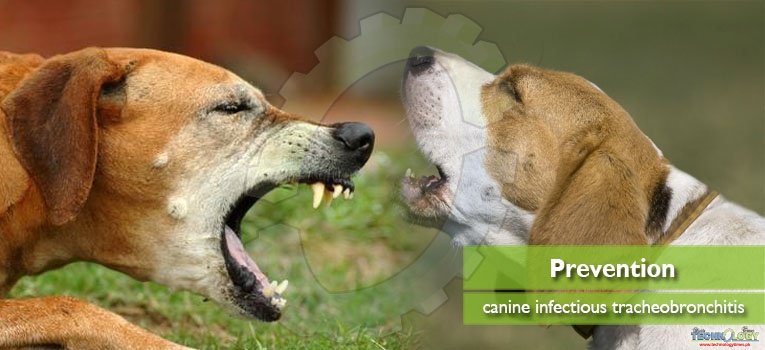Canine infectious tracheobronchitis is an acute, highly contagious respiratory disease that affects the larynx, trachea, bronchi, and occasionally the lower respiratory tract and parenchyma.

The term “kennel cough” is the commonly used synonym. Clinical signs range from very mild to severe. In mild cases, the dominant clinical sign is dry cough, but is most often associated with expectoration, and recovery usually occurs within 5-14 days.
Secondary bacterial broncho-pneumonia develops in severely affected or immunocompromised dogs. Acute severe haemorrhagic forms have been described that may be associated with one or two single pathogens.
Kennel cough is a single term used to cover acute infections caused by several different pathogens that are Bordetella bronchiseptica, canine parainfluenza virus (PI) and canine adenovirus type-2 (CAV-2). They are considered as the principal pathogens responsible for kennel cough.
Viruses other than PI and CAV-2 include the canine respiratory coronavirus (CRCoV), canine herpes virus, and canine influenza. Secondary infection may be there due to low immune status that may include Pasturella multocida, and Streptococcus zooepidemicus.
Disease is characterized by high fever, nasal discharge, dry or productive cough, pneumonia decrease appetite and disturbed breathing. Pathogens can spread through air, close contact or by fomites (contaminated inanimate objects). Direct contact with infected secretions is the most common way of disease transmission from dog to dog.
Exposure of disease
Exposure to clinical disease is mostly from infected dog kennels, dog parks, and dog shows. Vaccination against these pathogens is widely practiced. However, it is not uncommon for vaccinated dogs to develop clinical signs that can be due to vaccine failure or involvement of new pathogens. These pathogens have occurred despite of the widespread vaccination. Most of the infectious agent are inactivated by bleach.
All dogs are susceptible to disease, but mostly seen in pups and immunocompromised animals. Not only dogs, cats and immunocompromised humans can also get infection.
To prevent cross-species transmission separate or isolate the animal until the end of convalescent period. Crowding and stress are the major risk factor for severe respiratory disease. Increased population density, higher contact rate and reduced air quality leads to a greater risk of disease introduction. Insufficient facilities to provide proper care for the stray population, vaccine failure and environmental contamination are also responsible for transmission. We can prevent transmission by reducing the time of animal to stay in the shelter environment.
Vaccination
Vaccine failure is one of major reason for disease transmission. Some vaccines only provide partial protection. Vaccination is not important in controlling diseased cases while their frequency and severity can be significantly reduced. All dogs should have given recombinant subcutaneous vaccine or modified live vaccine (MLV) containing distemper immediately upon intake to a shelter. Puppies should be vaccinated starting at 4-6 weeks of age, and revaccinated every 2-3 weeks until 16-18 weeks of age. The younger age and shorter revaccination interval causes high risk of disease.
Disease spread
Environmental decontamination plays an important role in disease spread. Many pathogens do not survive in the environment for a long time. Distemper will survive for few hours, while Bordetella can survive for few weeks. They all are inactivated by routinely used disinfectants with exception of adenovirus.
High moisture in the environment will increase the survival of pathogens so it is important that surfaces will be in good repair and cleaning should be followed thorough drying. Way of cleaning is as important as the use of specific detergents or disinfectants. Itself cleaning process involved in spread of disease, rather than to prevent diseases. Disinfectant should be applied via sprayer rather than a bucket. Using a bucket will generally result in increased risk of disease transmission as they quickly become contaminated and act as fomites.
Removal or isolation of infected animal is also recommended. It is important that a mildly infected dog may have a serious disease. These dogs sometime play an important role in spreading and maintaining pathogen in a shelter population. A dog with a mild snotty nose may shed pathogens such as canine distemper or influenza which could be fatal for another animal.
Therefore, no matter disease is mild or severe remove all the symptomatic animals from shelter. All shelter staff and peoples should be trained to look at dogs carefully for clinical signs and scan for sneeze marks on kennel walls any time when they are interacting or observing the dogs. As we know that pathogen can be spread by airborne transmission. We must have isolation areas with separate air flow from the rest of the dog population so disease transmission can be controlled.
Treatment of canine infectious tracheobronchitis
There is no single drug of choice for disease treatment. Most commonly doxycycline and trimethoprim-sulfa are used. Aminophylline and cough suppressants are also used. Steroids are not recommended because it cause immune suppression. Supportive therapy is done to decrease mortality rate.
It is noted that many outbreaks of disease in dogs are not due to Bordetella bronchiseptica or Parainfluenza virus. Thus, many dogs will not be immunized against the causative organism. This means that cleaning or disinfection of the kennel environment is essential. It should be recognized that the effectiveness of any disinfection procedure is dependent on initial cleaning to remove contaminated materials.
The respiratory coronaviruses, for instance, remain infectious in feces for 2 days. However, CRCoV like most of the respiratory viruses are easily killed by common disinfectants after a minute although contact times of at least 30 minutes is recommended in field such as kennels. Infection was not considered that it harms human health.
However, research indicates that Bordetella bronchiseptica may cause disease in humans so young and immune compromised peoples should take precautions to come in contact of animal that have symptoms of tracheobronchitis.
This article is jointly written by Muhammad Hunain Ahmed, Muhammad Haider Ali, and Shiza Fatima.